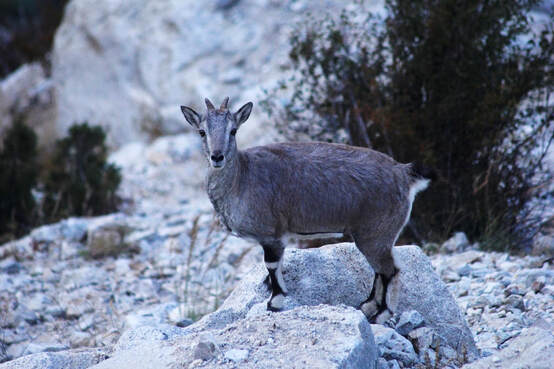In Search of the Greener Side: Resource Selection by Blue Sheep in Alpine Grasslands of Johar Valley
By
Ankita Bhattacharya
In the Indian Himalayan Region (IHR), rangelands include the Trans-Himalayan zone and the alpine meadows of the Greater Himalayan zone. These rangelands provide a wide range of habitats supporting unique arrays of biodiversity and ecosystem services. Transhumant pastoralism is one such service that has thrived in the Himalayan region for centuries. But in the last few decades, changes in livestock holdings, loss of traditional grazing patterns, and knowledge systems have greatly affected the wildlife, especially the wild ungulates. Mountain ungulates play a crucial role in maintaining the Himalayan rangeland ecosystem by shaping the vegetation structure, plant species composition, nutrient cycling, and forming prey base for carnivores. In light of current landscape approaches to conservation, it is thus important to assess the pressures of pastoralism across a landscape and degree of competition of livestock with wild ungulates based on available resources for a proper monitoring/management plan for rangelands. With this motivation, the study was carried out to investigate the effect of various topographical and environmental factors along with pastoralism on the resource selection by Blue sheep (Pseudois nayaur) in the Johar Valley, using the novel Point Process Model.
Naming Paradox
|
Blue Sheep is a widely distributed mountain ungulate from the steppes of Trans-Himalayas to Alpine meadows of Greater Himalayas.
But their name can be deceptive as Blue sheep is neither blue nor a sheep. Their coat is gray to pale brown, changing a bit between summer and winter. It is more closely related to Goat than Sheep.
The typical diet of Blue sheep consists of mainly grasses and herbs during summer and dried grass and lichens in the winters. It also forms an important part of a diet for various carnivores species in the Himalaya, especially, the Snow Leopard (Panthera uncia).
|
Jewel of Askot Landscape: Johar Valley
The study on Blue sheep was carried out in ~950 km2 of the upper catchment of the Gori River, referred to as the Johar valley, between 80° to 81°5'E Longitudes, and 29°5' to 30°N Latitudes in Uttarakhand state of Western Himalaya. It forms a part of the Askot Conservation Landscape in the Pithoragarh district. The valley forms the transition zone between the biogeographical elements of western Himalaya and Tibetan plateau covering an elevation range of 1918 m–6727 m. The variation in altitude creates habitats like sub-alpine and alpine birch forests, Krummholz zones of Rhododendron campanulatum and Juniper scrub, widespread moist (Greater Himalayan area) and dry (Trans Himalayan area) alpine habitats (locally known as bugyals), beyond which lie the glaciers and cold deserts merging with the Tibetan plateau. It harbors major ungulate species like Himalayan Goral (Naemorhedus goral), Himalayan Tahr (Hemitragus jemlahicus), Himalayan Musk Deer (Moschus chrysogaster) and Blue Sheep.
Landscape of the Johar Valley
Landscape of the Johar Valley
Sharing the Pastures
Apart from supporting a wide range of biodiversity, these rangelands provide livelihood opportunities for the local communities in the form of high-value medicinal herbs such as caterpillar fungus (Ophiocordyceps sinensis) and grazing resources for domestic livestock (sheep and goat) during the summer monsoon months. The main pastoralist community is Bhotiya, who live transhumance life, seasonally migrating to the alpine meadows from the valleys in search of better pastures for their herd. The prominent fodder plants in the alpine habitats are Danthonia spp. and Festuca spp., several species of Stipa spp., Carex spp., Selinum spp., etc. These rangelands are important nutritious foraging grounds for both wild and domestic ungulates in the summer, making it a battleground for resources. The seasonal abundance of highly nutritious forage during summer-monsoon months is suggested to be important for the survival of Blue sheep as well as livestock for the reminder year. Lesser the number of meadows, greater the competition for the resources. The livestock holds clear the advantage over Blue sheep due to the presence of pastoralists, who can guide them to nutritious grazing ground, driving away any competition.
Livestock in the Alpine Meadows
Herds of Livestock
in the Alpine Meadows
Search for the Greener Side
With the increasing resource competition, the important questions to answer are: how Blue sheep are adopting and distributing themselves in these habitats? What are the various factors governing their distribution and resource selection in the Johar valley?
To address the above questions, the resource selection function for Blue Sheep was estimated using the point process framework in this study. This model estimates the species distribution focusing observed data (as in this case presence-only data) and accordingly selecting the number of pseudo absence points required for the analysis. Further the expected number of Blue sheep presence per unit area at these points is modelled as a function of the important factors i.e. explanatory variables. These variables are elevation, terrain ruggedness, vegetation, aspect, slope, distance to escape terrain/ steep cliffs which are important to govern the selection of a particular site by Blue Sheep for grazing. The combination of direct observations, pseudo absence points, and explanatory variables generated in the GIS domain was considered during the analysis using the point process model to estimate the probability of the presence of Blue Sheep, Livestock, and their overlap in the area of interest.
The results of the study revealed that Blue Sheep prefers alpine grasslands (moist and dry), barren, and snow-covered areas. They also select the warmer aspects in moderately rugged terrains to forage on the grasses, and also showed a preference to remain a moderate distance (600 m –1000 m) from the escape terrain. Livestock, accompanied by pastoralists had a competitive advantage and preferred areas at lower elevations than Blue Sheep, with moderately rugged terrain, mainly on the valley floors. It is observed that the probability of area occupied by the Livestock is overlapped with ~39% of the predicted suitable area for the presence of the Blue Sheep. It is also observed that if given a choice, Blue Sheep will always prefer the valley floors and low altitude alpine patches interspersed with Krummholz zones and grassy slopes. But to avoid the pastoralists and Livestock, they are selecting the resources in more rugged areas that are less disturbed and inaccessible to humans, making compromise on the nutritious grass for the safety of topographic features.
The results of the study revealed that Blue Sheep prefers alpine grasslands (moist and dry), barren, and snow-covered areas. They also select the warmer aspects in moderately rugged terrains to forage on the grasses, and also showed a preference to remain a moderate distance (600 m –1000 m) from the escape terrain. Livestock, accompanied by pastoralists had a competitive advantage and preferred areas at lower elevations than Blue Sheep, with moderately rugged terrain, mainly on the valley floors. It is observed that the probability of area occupied by the Livestock is overlapped with ~39% of the predicted suitable area for the presence of the Blue Sheep. It is also observed that if given a choice, Blue Sheep will always prefer the valley floors and low altitude alpine patches interspersed with Krummholz zones and grassy slopes. But to avoid the pastoralists and Livestock, they are selecting the resources in more rugged areas that are less disturbed and inaccessible to humans, making compromise on the nutritious grass for the safety of topographic features.
Various Habitats in the Johar Valley
Habitats in the Johar Valley
Making Meadows Blue Sheep Friendly
The estimation of the distribution of Blue Sheep and factors affecting their resource selection with respect to livestock can be used to formulate the conservation plan for the rangeland by managing the pastoral practices in the Johar Valley. Some of the identified optimal pastures from the Johar valley can be excluded from the pastoral areas for the Livestock, providing exclusive access to Blue Sheep. With the proper application of the point process model, it can be further used to identify areas across Himalayan landscapes with a high potential of being a good habitat for Blue Sheep. These areas can be further treated as the priority areas for habitat conservation with the active participation of pastoral communities and local stakeholders. It will help to reduce the competition for the resources between Blue Sheep and livestock,allowing their co-existence in long term.
Sharing the Meadows
Sharing the Meadows
with the Pastoralists
Link to the research paper: http://zoolstud.sinica.edu.tw/Journals/59/59-11.html
Citation: Bhattacharya, A., Chatterjee, N., Rawat, G.S., and Habib, B., 2020. Blue Sheep Resource Selection in Alpine Grasslands of a Western Himalayan Landscape–A Point Process Approach. Zoological Studies, 59(2020).
Note: The study was funded by World Bank and conducted by Wildlife Institute of India, Dehradun under the Biodiversity Conservation and Rural Livelihood Improvement Project (BCRLIP).
Citation: Bhattacharya, A., Chatterjee, N., Rawat, G.S., and Habib, B., 2020. Blue Sheep Resource Selection in Alpine Grasslands of a Western Himalayan Landscape–A Point Process Approach. Zoological Studies, 59(2020).
Note: The study was funded by World Bank and conducted by Wildlife Institute of India, Dehradun under the Biodiversity Conservation and Rural Livelihood Improvement Project (BCRLIP).
|
03-07-2020
|
Explore I Share
|
|
Books and television played a major role in tweaking her curiosity for the animal world. During her Bachelor’s and Master’s degree in Zoology from the University of Calcutta, her interest grew owing to educational tours to some of the protected areas in India and motivational teachers. Needless to say, it didn’t take much convincing for her to choose a career for which she is passionate about. She have worked as a research scholar at the Wildlife Institute of India on the distribution and status of mammals in Uttarakhand and Himachal Pradesh. She is a huge admirer of the mountain ecosystems and currently pursuing her Ph.D. on mountain ungulates from Wildlife Institute of India. Her interest is particularly in high altitude camera trapping and species distribution modelling. Alongside She is fond of food, music, reading, and travelling. |


